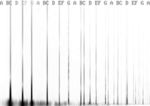In mathematics, the convolution theorem states that under suitable conditions the Fourier transform of a convolution of two functions (or signals) is the...
22 KB (1,986 words) - 15:54, 21 January 2024
In mathematics (in particular, functional analysis), convolution is a mathematical operation on two functions ( f {\displaystyle f} and g {\displaystyle...
67 KB (8,780 words) - 06:49, 21 May 2024
Discrete Fourier transform (redirect from Circular convolution theorem)
e^{-{\frac {i2\pi }{N}}km}} The convolution theorem for the discrete-time Fourier transform (DTFT) indicates that a convolution of two sequences can be obtained...
68 KB (10,510 words) - 12:55, 30 April 2024
The Titchmarsh convolution theorem describes the properties of the support of the convolution of two functions. It was proven by Edward Charles Titchmarsh...
6 KB (814 words) - 22:40, 13 January 2024
_{X}\right]\exp \left[-{\tfrac {\sigma _{X}^{2}\omega ^{2}}{2}}\right]} By the convolution theorem: f Z ( z ) = ( f X ∗ f Y ) ( z ) = F − 1 { F { f X } ⋅ F { f Y }...
13 KB (3,326 words) - 19:26, 12 August 2023
discrete convolution is the discrete analog of the multidimensional convolution of functions on Euclidean space. It is also a special case of convolution on...
41 KB (8,119 words) - 00:23, 19 April 2023
mathematics, convolution is a binary operation on functions. Circular convolution Convolution theorem Titchmarsh convolution theorem Dirichlet convolution Infimal...
875 bytes (115 words) - 21:17, 12 October 2022
Circular convolution, also known as cyclic convolution, is a special case of periodic convolution, which is the convolution of two periodic functions that...
11 KB (1,276 words) - 10:42, 21 May 2024
Fourier transform hold for the inverse Fourier transform, such as the Convolution theorem and the Riemann–Lebesgue lemma. Tables of Fourier transforms may...
18 KB (3,650 words) - 15:39, 15 December 2023
Fourier transform (redirect from Fourier shift theorem)
frequency domain. Also, convolution in the time domain corresponds to ordinary multiplication in the frequency domain (see Convolution theorem). After performing...
177 KB (21,038 words) - 02:51, 22 May 2024



